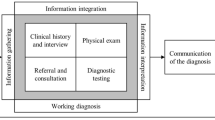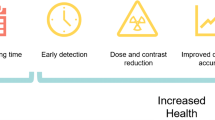Abstract
Case-Based Reasoning (CBR) has been applied in many different medical applications. Due to the complexities and the diversities of this domain, most medical CBR systems become hybrid. Besides, the case adaptation process in CBR is often a challenging issue as it is traditionally carried out manually by domain experts. In this paper, a new hybrid case-based reasoning approach for medical diagnosis systems is proposed to improve the accuracy of the retrieval-only CBR systems. The approach integrates case-based reasoning and rule-based reasoning, and also applies the adaptation process automatically by exploiting adaptation rules. Both adaptation rules and reasoning rules are generated from the case-base. After solving a new case, the case-base is expanded, and both adaptation and reasoning rules are updated. To evaluate the proposed approach, a prototype was implemented and experimented to diagnose breast cancer and thyroid diseases. The final results show that the proposed approach increases the diagnosing accuracy of the retrieval-only CBR systems, and provides a reliable accuracy comparing to the current breast cancer and thyroid diagnosis systems.















Similar content being viewed by others
References
Ahmed, M. U., Begum, S., and Funk, P., A hybrid case-based system in stress diagnosis and treatment. In IEEE-EMBS International Conference on Biomedical and Health Informatics (BHI2012), 2012.
Sahin, S., Tolun, M. R., and Hassanpour, R., Hybrid expert systems: A survey of current approaches and applications. Expert Syst Appl 39(4):4609–4617, 2012.
Bichindaritz, I., and Montani, S., Advances in case-based reasoning in the health sciences. Artif Intell Med 51(2):75–79, 2011.
Kolodner, J., Case based reasoning. Morgan Kauffman. San Mateo, California, 1993.
Aamodt, A., and Plaza, E., Case-based reasoning: Foundational issues, methodological variations, and system approaches. AI Commun 7(1):39–59, 1994.
Baumeister, J., Atzmueller, M., and Puppe, F., Inductive learning for case-based diagnosis with multiple faults. In Advances in case-based reasoning (pp. 28–42). Springer Berlin Heidelberg, 2002.
Hunt, J., and Miles, R., Hybrid case-based reasoning. Knowl Eng Rev 9(4):383–398, 1994.
Lenz, M., Bartsch-Spörl, B., Burkhard, H. D., and Wess, S., Case-based reasoning technology, from foundations to applications. Springer-Verlag, 1998.
Macura, R. T., and Macura, K., Case-based reasoning: Opportunities and applications in health care. Artif Intell Med 9(1):1–4, 1997.
Begum, S., Ahmed, M. U., Funk, P., Xiong, N., and Folke, M., Case-based reasoning systems in the health sciences: A survey of recent trends and developments. Syst Man Cybern Part C Appl Rev IEEE Trans 41(4):421–434, 2011.
Sharaf-Eldeen, D. A., Moawad, I. F., El Bahnasy, K., and Khalifa, M. E., Learning and applying range adaptation rules in case-based reasoning systems. In Advanced Machine Learning Technologies and Applications (pp. 487–495). Springer Berlin Heidelberg, 2012
Sharaf-el Deen, D. A., Moawad, I. F., and Khalifa, M. E., A breast cancer diagnosis system using hybrid case-based approach. Int J Comp Appl 72(23):14–20, 2013.
Li, H., Li, X., Hu, D., Hao, T., Wenyin, L., and Chen, X., Adaptation rule learning for case‐based reasoning. Concurr Comput Pract Experience 21(5):673–689, 2009.
Yusof, M. M., and Buckingham, C. D., Medical case-based reasoning: A review of retrieving, matching and adaptation processes in recent systems. In Proceedings of the IASTED International Conference (Vol. 639, p. 053), 2009.
Huang, M. J., Chen, M. Y., and Lee, S. C., Integrating data mining with case-based reasoning for chronic diseases prognosis and diagnosis. Expert Syst Appl 32(3):856–867, 2007.
Schmidt, R., and Vorobieva, O., Case-based reasoning investigation of therapy inefficacy. Knowl-Based Syst 19(5):333–340, 2006.
Marling, C., Shubrook, J., and Schwartz, F., Case-based decision support for patients with type 1 diabetes on insulin pump therapy. In Advances in Case-Based Reasoning (pp. 325–339). Springer Berlin Heidelberg, 2008.
Schmidt, R., and Gierl, L., A prognostic model for temporal courses that combines temporal abstraction and case-based reasoning. Int J Med Inform 74(2):307–315, 2005.
Ochoa, A., Meza, M., González, S., Padilla, A., Damiè, M., Torre, D. L. J., and Jiménez-Vielma, F., An intelligent tutor based on case-based reasoning to medical use. Advances in Computer Science and Engineering. Res Comput Sci 34:187–194, 2008.
O’Sullivan, D., Bertolotto, M., Wilson, D., and McLoghlin, E., Fusing mobile case-based decision support with intelligent patient knowledge management. In Workshop on CBR in the Health Sciences (pp. 151–160), 2006.
Ayer, T., Ayvaci, M. U., Liu, Z. X., Alagoz, O., and Burnside, E. S., Computer-aided diagnostic models in breast cancer screening. Imaging 2(3):313–323, 2010.
Huang, M. L., Hung, Y. H., Lee, W. M., Li, R. K., and Wang, T. H., Usage of case-based reasoning, neural network and adaptive neuro-fuzzy inference system classification techniques in breast cancer dataset classification diagnosis. J Med Syst 36(2):407–414, 2012.
Temurtas, F., A comparative study on thyroid disease diagnosis using neural networks. Expert Syst Appl 36(1):944–949, 2009.
Ozyilmaz, L., and Yildirim, T., Diagnosis of thyroid disease using artificial neural network methods. In Neural Information Processing, 2002. ICONIP’02. Proceedings of the 9th International Conference on (Vol. 4, pp. 2033–2036). IEEE, 2002, November.
Serpen, G., Jiang, H., and Allred, L., Performance analysis of probabilistic potential function neural network classifier. In Proceedings of artificial neural networks in engineering conference, St. Louis, MO (Vol. 7, pp. 471–476), 1997.
Pasi, L., Similarity classifier applied to medical data sets, 2004, 10 sivua, Fuzziness in Finland’04. In International conference on soft computing, Helsinki, Finland & Gulf of Finland & Tallinn, Estonia, 2004.
Polat, K., Şahan, S., and Güneş, S., A novel hybrid method based on artificial immune recognition system (AIRS) with fuzzy weighted pre-processing for thyroid disease diagnosis. Expert Syst Appl 32(4):1141–1147, 2007.
Keleş, A., and Keleş, A., ESTDD: Expert system for thyroid diseases diagnosis. Expert Syst Appl 34(1):242–246, 2008.
Dogantekin, E., Dogantekin, A., and Avci, D., An expert system based on generalized discriminant analysis and wavelet support vector machine for diagnosis of thyroid diseases. Expert Syst Appl 38(1):146–150, 2011.
Chen, H. L., Yang, B., Wang, G., Liu, J., Chen, Y. D., and Liu, D. Y., A three-stage expert system based on support vector machines for thyroid disease diagnosis. Journal of medical systems 36(3):1953–1963, 2012.
Srimani, P. K., and Koti, M. S., Medical diagnosis using ensemble classifiers-a novel machine-learning approach. J Adv Comput 1:9–27, 2013.
Pawlak, Z., Rough sets. Int J Comput Inf Sci 11(5):341–356, 1982.
Hanney, K., and Keane, M. T., Learning adaptation rules from a case-base (pp. 179–192). Springer Berlin Heidelberg, 1996.
Gu, M., Tong, X., and Aamodt, A., Comparing similarity calculation methods in conversational cbr. In Information Reuse and Integration, Conf, 2005. IRI-2005 I.E. International Conference on. (pp. 427–432). IEEE, 2005, August.
Craw, S., Wiratunga, N., and Rowe, R. C., Learning adaptation knowledge to improve case-based reasoning. Artif Intell 170(16):1175–1192, 2006.
Yang, Y. P. O., Shieh, H. M., Tzeng, G. H., Yen, L., & Chan, C. C., Business aviation decision-making using rough sets. In Rough Sets and Current Trends in Computing (pp. 329–338). Springer Berlin Heidelberg, 2008, January.
Shyng, J. Y., Wang, F. K., Tzeng, G. H., and Wu, K. S., Rough set theory in analyzing the attributes of combination values for the insurance market. Expert Syst Appl 32(1):56–64, 2007.
Pawlak, Z., Rough sets: Theoretical aspects of reasoning about data, system theory, Knowledge Engineering and Problem Solving, vol. 9, 1991.
Van Rijsbergen C. J., (1994). Rough sets, fuzzy sets and knowledge discovery (Vol. 15). In: Ziarko, W. P., (Ed.). London: Springer-Verlag.
Chang, C. G., Cui, J. J., Wang, D. W., and Hu, K. Y., Research on case adaptation techniques in case-based reasoning. In Machine Learning and Cybernetics, 2004. Proceedings of 2004 International Conference on (Vol. 4, pp. 2128–2133). IEEE, 2004, August.
http://archive.ics.uci.edu/ml/machine-learning-databases, last accessed September 2013.
Salzberg, S. L., On comparing classifiers: Pitfalls to avoid and a recommended approach. Data Min Knowl Discov 1(3):317–328, 1997.
Park, S. H., Goo, J. M., and Jo, C. H., Receiver operating characteristic (ROC) curve: Practical review for radiologists. Korean J Radiol 5(1):11–18, 2004.
Jiang, Y., Nishikawa, R. M., Wolverton, D. E., Metz, C. E., Giger, M. L., Schmidt, R. A., and Doi, K., Malignant and benign clustered microcalcifications: automated feature analysis and classification. Radiology 198(3):671–678, 1996.
Markopoulos, C., Kouskos, E., Koufopoulos, K., Kyriakou, V., and Gogas, J., Use of artificial neural networks (computer analysis) in the diagnosis of microcalcifications on mammography. Eur J Radiol 39(1):60–65, 2001.
Huo, Z., Giger, M. L., Vyborny, C. J., and Metz, C. E., Breast cancer: Effectiveness of computer-aided diagnosis—observer study with independent database of mammograms1. Radiology 224(2):560–568, 2002.
Floyd, C. E., Jr., Lo, J. Y., and Tourassi, G. D., Case-based reasoning computer algorithm that uses mammographic findings for breast biopsy decisions. Am J Roentgenol 175(5):1347–1352, 2000.
Elter, M., Schulz-Wendtland, R., and Wittenberg, T., The prediction of breast cancer biopsy outcomes using two CAD approaches that both emphasize an intelligible decision process. Med Phys 34:4164, 2007.
Chan, H. P., Sahiner, B., Helvie, M. A., Petrick, N., Roubidoux, M. A., Wilson, T. E., and Sanjay-Gopal, S., Improvement of radiologists’ characterization of mammographic masses by using computer-aided diagnosis: An ROC study1. Radiology 212(3):817–827, 1999.
Gupta, S., Chyn, P. F., and Markey, M. K., Breast cancer CAD based on BI-RADS™ descriptors from two mammographic views. Med Phys 33:1810, 2006.
Wang, X. H., Zheng, B., Good, W. F., King, J. L., and Chang, Y. H., Computer-assisted diagnosis of breast cancer using a data-driven Bayesian belief network. Int J Med Inform 54(2):115–126, 1999.
Chhatwal, J., Alagoz, O., Lindstrom, M. J., Kahn, C. E., Shaffer, K. A., and Burnside, E. S., A logistic regression model based on the national mammography database format to aid breast cancer diagnosis. Am J Roentgenol 192(4):1117–1127, 2009.
Burnside, E. S., Davis, J., Chhatwal, J., Alagoz, O., Lindstrom, M. J., Geller, B. M., and Page, C. D., Probabilistic computer model developed from clinical data in national mammography database format to classify mammographic findings1. Radiology 251(3):663–672, 2009.
Ayer, T., Alagoz, O., Chhatwal, J., Shavlik, J. W., Kahn, C. E., and Burnside, E. S., Breast cancer risk estimation with artificial neural networks revisited. Cancer 116(14):3310–3321, 2010.
Bilska-Wolak, A. O., Floyd, C. E., Jr., Lo, J. Y., and Baker, J. A., Computer aid for decision to biopsy breast masses on mammography: Validation on new cases1. Acad Radiol 12(6):671–680, 2005.
Author information
Authors and Affiliations
Corresponding author
Rights and permissions
About this article
Cite this article
Sharaf-El-Deen, D.A., Moawad, I.F. & Khalifa, M.E. A New Hybrid Case-Based Reasoning Approach for Medical Diagnosis Systems. J Med Syst 38, 9 (2014). https://doi.org/10.1007/s10916-014-0009-1
Received:
Accepted:
Published:
DOI: https://doi.org/10.1007/s10916-014-0009-1




